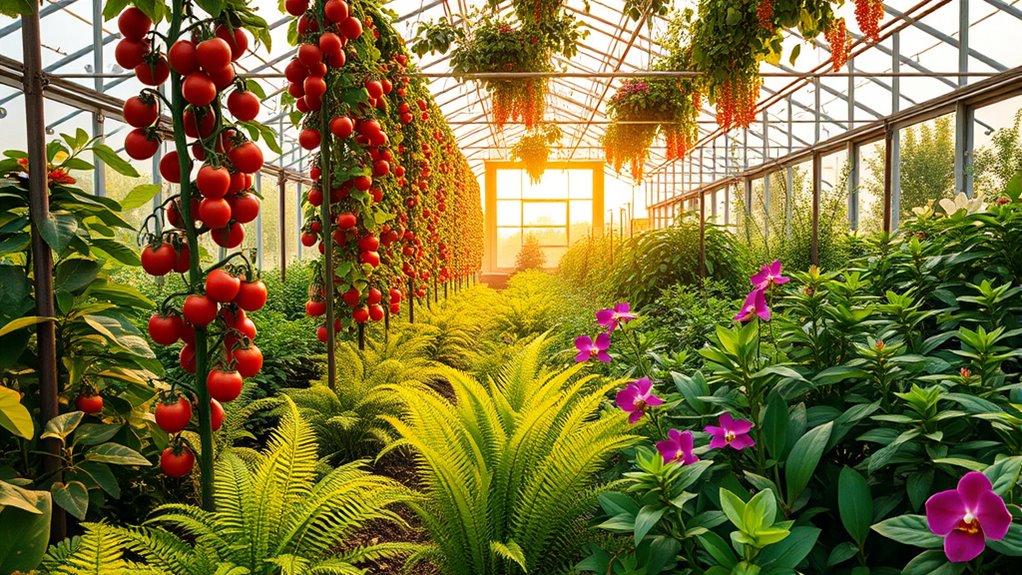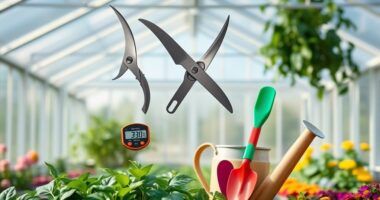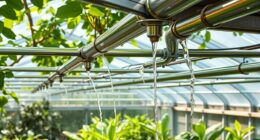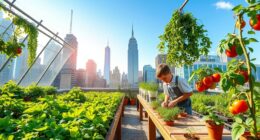To get the best results, focus on plants that thrive in controlled environments, like tomatoes, peppers, and herbs. Tropical favorites such as orchids, bananas, and passionfruit require high humidity and warmth, while cool-weather crops like lettuce and herbs prefer less intense conditions. Managing temperature, humidity, light, and ventilation keeps your plants healthy and productive. To discover the ideal greenhouse setup for your plants and maximize your yields, continue exploring effective climate control tips and plant choices.
Key Takeaways
- Choose plants like tomatoes, peppers, ferns, and orchids suited to controlled environment conditions.
- Manage temperature, humidity, and light to mimic ideal growing environments for different plant types.
- Use supplemental lighting and shade cloths to optimize light exposure during short winter days.
- Consider your regional climate when selecting plants, adjusting conditions for tropical or cool-weather varieties.
- Gradually expand plant selection as your climate control skills improve, ensuring healthy growth and higher yields.
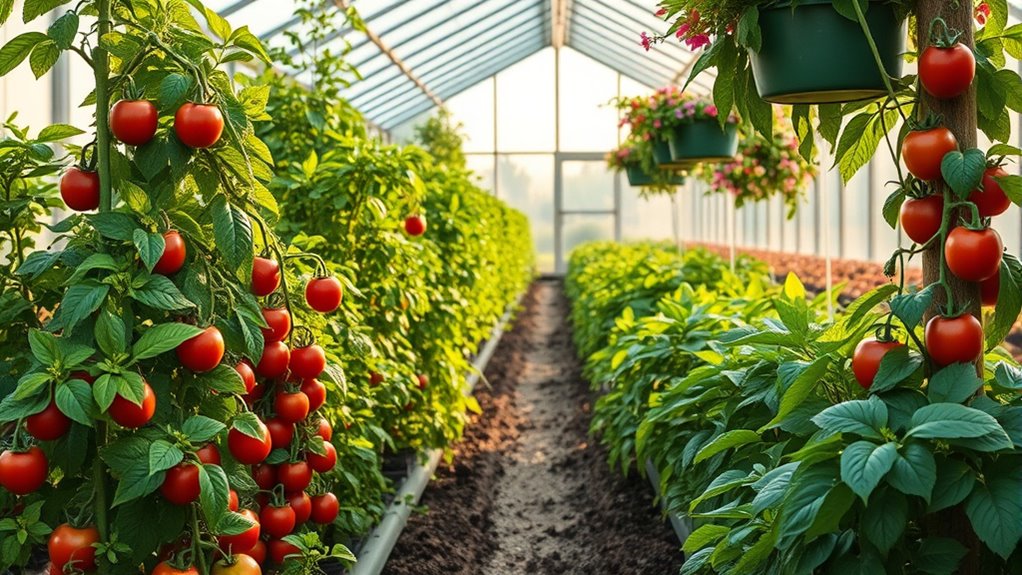
A greenhouse provides the perfect environment to grow a wide variety of plants year-round, regardless of outdoor weather conditions. To make the most of this space, you need to carefully consider choosing plant varieties that thrive in greenhouse settings. Not all plants are suited for enclosed environments, so focus on those that benefit from controlled conditions. When selecting your plants, think about their specific needs for light, humidity, and temperature. Some plants, like tomatoes and peppers, thrive in warm, sunny conditions, while others, such as ferns and orchids, prefer more humid atmospheres. By choosing the right varieties, you can guarantee healthier growth and higher yields.
One of the key factors in successful greenhouse gardening is greenhouse climate control. This involves managing temperature, humidity, ventilation, and light levels to mimic ideal growing conditions for your selected plants. Proper climate control allows you to extend growing seasons and protect plants from pests and diseases that are common outdoors. For instance, installing heaters and fans helps maintain consistent temperatures, preventing cold snaps or excessive heat that could stress your plants. Automated vent systems facilitate airflow, reducing humidity levels that could lead to mold or mildew. Shade cloths or supplemental lighting can also be used to maximize light exposure, especially during shorter winter days. Additionally, understanding the specific needs of your plant varieties helps optimize your climate control strategies.
When choosing plant varieties, consider your local climate and the specific conditions inside your greenhouse. Some plants require more warmth and light, while others flourish in cooler, shaded environments. For example, tropical plants like bananas or passionfruit might need extra heating and high humidity, whereas herbs like basil or lettuce prefer less intense conditions. By selecting varieties that align with your greenhouse’s environment, you reduce the need for excessive climate adjustments and make your gardening efforts more efficient.
Implementing effective greenhouse climate control systems not only enhances plant health but also allows you to experiment with a wider range of species. You can grow delicate orchids or exotic fruits that wouldn’t survive outdoors in your region. It’s essential, however, to start with plant varieties that suit your current setup and gradually expand as you become more comfortable managing your climate controls. Regular monitoring and adjustments ensure your plants stay in ideal conditions, resulting in lush growth and bountiful harvests.
Frequently Asked Questions
How Do I Control Humidity Levels in My Greenhouse?
To control humidity levels in your greenhouse, focus on humidity regulation and moisture control. Use a hygrometer to monitor levels and adjust ventilation accordingly. Increase airflow by opening vents or installing exhaust fans to reduce excess moisture, especially during humid days. On dry days, you can add a humidifier. Regularly remove standing water and make certain proper watering practices to maintain ideal humidity, creating a healthier environment for your plants.
What Are the Best Pest Management Strategies for Greenhouse Plants?
To manage pests effectively, you should adopt integrated pest management, combining cultural, mechanical, and biological controls. Use biological control by introducing beneficial insects like ladybugs or predatory mites to naturally reduce pest populations. Regularly monitor your plants for early signs of pests, and act quickly to prevent infestations. Avoid chemical pesticides whenever possible, as they can harm beneficial insects and disrupt your pest control balance.
How Often Should I Water Different Greenhouse Plants?
Did you know that overwatering causes 60% of greenhouse plant issues? When it comes to watering schedules, you should tailor your approach to each plant’s needs. Some plants prefer moist soil, while others thrive with dry roots. To guarantee proper plant hydration, check soil moisture regularly and avoid overwatering or underwatering. Adjust your watering routine based on plant type, pot size, and environmental conditions for healthy growth.
What Lighting Conditions Are Ideal for Tropical Greenhouse Plants?
For tropical plant care, you need to provide bright, indirect light, mimicking their natural environment. Use greenhouse lighting techniques like grow lights or diffusers to prevent direct sunburn while ensuring enough light. Ideally, keep daytime temperatures between 65-80°F. Adjust lighting based on the season, and monitor your plants for signs of too much or too little light. Proper lighting helps your tropical plants thrive indoors.
How Can I Extend the Growing Season in My Greenhouse?
Ever wonder how to keep your garden thriving longer? You can extend the growing season in your greenhouse by using season extension techniques like heating, shading, or installing grow lights. Practicing crop rotation guarantees soil nutrients stay balanced, promoting healthy growth year-round. By combining these strategies, you maximize your greenhouse’s productivity, allowing you to enjoy fresh produce longer and make the most of your gardening efforts.
Conclusion
With the right choices, your greenhouse can become a lush paradise bursting with life. From vibrant vegetables to exotic flowers, these plants will thrive under your care, transforming your space into a botanical wonderland. Remember, with patience and dedication, you’ll turn your greenhouse into a thriving oasis so spectacular, it’ll make even the most renowned gardens seem tiny. Keep experimenting, and soon you’ll be the envy of every gardener around!
